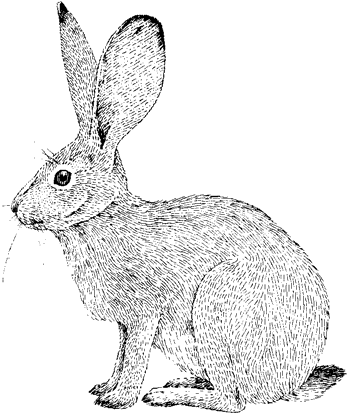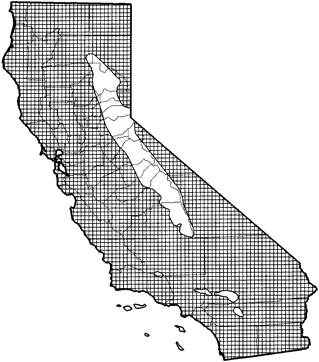
Black-tailed Jackrabbit
Distribution, Abundance, and Seasonality
Common throughout the state, except at the highest elevations. Abundant at lower elevations in herbaceous and desert-shrub areas and open, early stages of forest and chaparral habitats.

Range Map
Specific Habitat Requirements
Feeding: Strictly herbivorous; graze and browse. They prefer grasses and forbs but will eat almost any vegetation that occurs in the area, up to about 51 cm (20 in) above the ground. Chew and Chew (1970) found 65% of the diet was shrub browse, and 30% was herbage. Diet changes with forage availability by season. Coprophagous (Flinders and Hansen 1972).
Cover: Uses shrubs for cover.
Reproduction: Young are born beneath vegetation that provides some overhead cover. As in other hares (Genus Lepus)l no special nest structure is built.
Water: Water is not necessary, but it will be drunk if available.
Pattern: Intermediate canopy stages of shrub habitats, and open shrub/herbaceous and tree/herbaceous edges provide suitable habitat.
Species Life History
Activity Patterns: Yearlong diurnal and crepuscular activity.
Seasonal Movements / Migration: Non-migratory.
Home Range: Home ranges in California averaged 18.5 ha (45 ac) (Lechleitner 1958). In Kansas, Tiemeier (1965) estimated home ranges from 4-79 ha (10-194 ac). In Utah, densities have been calculated at 100 per km2 (260/mi2) (Flinders and Hansen 1973).
Territory: Probably not territorial, at least in Kansas (Tiemeier 1965).
Reproduction: Breeds throughout the year, with greatest number of births occurring from April through May (Ingles 1965). Gestation period is 43 days. Up to 4 litters of 3-4 young (range 1-8) produced per yr. Young weaned at 3 wks. A yr-old female may produce 14, or more, young per yr (Ingles 1965). Populations may fluctuate in 3-6-yr intervals, and may increase up to 9-fold. This species mostly is solitary, except when mating and raising young.
Niche: Because of their great adaptability, and rapid rate of reproduction, black-tailed hares can become pests. Tularemia, plague, and skin diseases are carried by this species. Predators include coyotes, eagles, northern harriers, barn owls, red-tailed hawks, great horned owls, rattlesnakes, and gopher snakes. Competitors for food primarily include other grazers and browsers. Also called black-tailed jackrabbit.
Sources & References
California Department of Fish and Game, 1999.
California's Wildlife, Sacramento, CA.
Written by: C. Polite, reviewed by: M. White, edited by: M. White
Chew, R. M., and A. E. Chew. 1970. Energy relationships of the mammals of a desert shrub Flinders, J. T., and R. M. Hansen. 1972. Diets and habits of jackrabbits in northeastern Colorado. Colorado State Univ., Range Sci. Dep. Sci. Ser. 12. 29pp. Flinders, J. T., and R. M. Hansen. 1973. Abundance and dispersion of leporids within a shortgrass ecosystem. J. Mammal. 54:287-291. Ingles, L. G. 1965. Mammals of the Pacific states. Stanford Univ. Press, Stanford, CA. 506pp. Lechleitner, R. R. 1958. Movements, density, and mortality in a black-tailed jackrabbit population. J. Wildl. Manage. 22:371-384. Lechleitner, R. R. 1959. Sex ratio, age classes and reproduction of the black-tailed jackrabbit. J. Mammal. 40:63-81. Orr, R. T. 1940. The rabbits of California. Calif. Acad. Sci. Occas. Pap. No. 19. 227pp. Tiemeier, O. W. 1965. The black-tailed jackrabbit in Kansas. Kansas State Univ. Agric. Exp. Sta., Manhattan. Contrib. No. 336. 75pp.
California Animal Facts | California's Wildlife